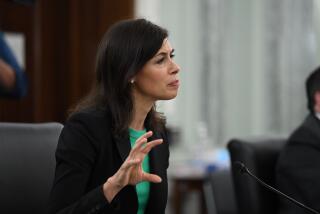FCC Steps Up Airwave Hunt
- Share via
WASHINGTON — Federal regulators and industry officials have stepped up their search for more airwaves for the beleaguered wireless industry as carriers try to stave off the financial carnage that has engulfed the rest of the telecom industry.
A shortage of airwaves has forced Sprint PCS Group, VoiceStream Wireless and other companies to borrow heavily to handle calls placed by the nation’s 128 million mobile phone users.
For the record:
12:00 a.m. July 10, 2002 For The Record
Los Angeles Times Wednesday July 10, 2002 Home Edition Main News Part A Page 2 National Desk 10 inches; 382 words Type of Material: Correction
Nextel’s cash--A story in Friday’s Business section about a shortage of airwaves for the wireless industry incorrectly reported that Nextel Communications Inc. had $1 billion in cash. The company has $3 billion in cash.
*
Although wireless companies are spending nearly $10 billion this year to expand calling capacity and provide new high-speed data services, revenue per minute of mobile telephone use has plummeted to 14 cents, from 53 cents in 1992, according to industry figures.
That’s because the industry’s titans, in an effort to gain market share, have been underpricing their services relative to their costs.
“There’s a basic rule of economics: If you sell something for $1 that costs you $1.05, you can’t make money,” said Herschel Shosteck, president of Shosteck Group, a Wheaton, Md., telecommunications consulting firm.
A major spectrum expansion is critical if the industry is to avert an erosion in the quality of cell phone service or a financial meltdown in the next two years, analysts said. At stake are the pace of innovation in a key industry sector and tens of thousands of jobs. That’s particularly true in California, the industry’s nerve center and home to Qualcomm Inc. and about 2,000 other wireless firms employing 60,000 workers.
“There are so many types of events out there that could spell doom for the industry,” said Adam Zawel, an analyst for Cambridge, Mass.-based Yankee Group, citing uncertain government policy, new competing wireless technologies and the economy. “But there are also still a heck of a lot of people out there without a cell phone,” Zawel said. “The challenge is ... to get more phones into the market and get everyone to use advanced wireless services,” which generate more revenue.
In a controversial move to alleviate the crunch, the Federal Communications Commission announced last week that it would auction 740 wireless licenses beginning Aug. 27. But those airwaves are currently used by television broadcasters, and some wireless firms and lawmakers have opposed an auction because carriers would then be forced to spend years and hundreds of millions of dollars to relocate broadcasters to other parts of the spectrum.
What’s more, those airwaves represent only about 78 megahertz of spectrum, about one-third of the 200 MHz the industry says it needs to satisfy wireless demand.
“The wireless revolution is becoming a victim of its own success,” said Thomas J. Sugrue, chief of the Federal Communications Commission’s wireless bureau. “The simple truth is that as our society grows increasingly dependent on wireless technology and services, spectrum demand is stressing the supply, and that has made spectrum management difficult for government.”
This bleak picture is a stark contrast with two years ago, when the wireless industry was flying high and aggressively building networks and pursuing acquisitions. But carriers have since found it more difficult to attract customers because most American consumers who want a mobile phone now have one. The remaining 50% of Americans who don’t have one are mostly the elderly, the poor and children too young to own a phone.
Carriers have compounded their woes by following in the footsteps of dot-com and fiber-optic entrepreneurs, borrowing too heavily and building too aggressively in the face of slowing demand. The number of mobile phone subscribers will increase 14% this year--an all-time low rate, according to Prudential Securities Inc.
With less business to go around, experts predict the industry will shrink to no more than four major players within two years.
One likely combination, industry experts said, involves the nation’s No. 3 carrier, AT&T; Wireless, and No. 2 Cingular Wireless, which is owned by SBC Communications Inc. and BellSouth Corp. Because their networks share similar technology, the two firms could save billions of dollars by combining. Market leader Verizon Wireless could achieve a similar synergy by acquiring No. 4 Sprint PCS, experts said.
But Sprint may still be wary of a deal after the Justice Department’s rejection of its proposed $115-billion merger with WorldCom Inc. two years ago. And federal regulators are likely to be skeptical of mergers that would leave 65% of the wireless market controlled by two companies owned by the regional Bells. The fear is that the Bells might then easily overwhelm the market’s remaining two weaker competitors, Nextel Communications Inc. and VoiceStream.
The unpleasant options leave the industry’s major players with little choice but to hunker down, for now.
Nextel, which is carrying $14 billion in debt, has slashed capital spending 20% to $2 billion this year. But the company continues to generate cash and remains hopeful that its “credit profile will improve significantly over the next few years” from subscriber growth and lower operating costs, Chief Financial Officer Paul Saleh said.
Nextel hopes to keep afloat for the short term with $1 billion in cash, a line of bank credit for $1.5 billion and other sources that might provide as much as $5 billion more in capital if needed.
Rival Sprint PCS faces a similar cash crunch. Though the company added 4 million subscribers last year, it lost $1.25 billion in 2001 and recently reduced its 2002 wireless subscriber growth forecast by 10% to 15% from an earlier target of 3 million. Executives even have hinted at selling assets to improve Sprint’s balance sheets.
“A lack of capital will continue to hamstring expansion plans,” Sprint Corp. Chairman William E. Esry said in a speech at an Atlanta trade show last month. But, he added, Sprint is still committed to delivering a wireless network “where you can move from your office to your home ... with total uninterrupted, fast and secure communications.”
The diminutive cell phone seems an unlikely device to drive such an ambitious strategy.
When introduced 20 years ago, cell phones weighed as much as a brick and cost more than $3,000. The FCC, which in 1982 set aside 40 MHz of spectrum for mobile phones--nearly seven times the amount used by a single television station--believed it would take decades for demand to exceed capacity, recalled Martin Cooper, a former project manager at Motorola Inc. who is known as the father of cellular phones for his pioneering work on the technology in the early 1970s.
But the devices proved an immediate hit with on-the-go consumers who reaped the benefits of a take-no-prisoners price war among carriers. The demand forced the FCC to quadruple to 180 MHz the amount of airwaves devoted to wireless services.
The demand also has spawned a vicious upgrade cycle that has forced carriers to spend billions of dollars each year on system improvements. After building the initial analog phone system, for instance, carriers spent billions more to add digital mobile phone service. Now, with another costly upgrade in the works--this time for high-speed Internet access--profits will elude the wireless industry for at least two more years, predicts Roger Enter, a wireless analyst for Yankee Group.
But carriers are betting that consumers will flock to high-speed phones, which will allow them to do such things as display maps for travel directions, download audio files and use other potentially lucrative subscriber services.
However, even if high-speed wireless data appeal to consumers, their growth probably will be constrained by the shortage of airwaves that appears more dire now than it did only a few months ago.
The industry has been seeking to double the amount of spectrum allocated for wireless use. Carriers have been eyeing a 140-MHz swath of airwaves in the 1710-MHz-to-1850-MHz band that the military is using for defense operations, as well as a 190-MHz block of airwaves being used by some of the nation’s universities and churches for educational television and wireless networking
But in the wake of the Sept. 11 terrorist attacks, the Pentagon has strengthened its hold on its airwaves. In October, the Commerce Department, which manages airwaves owned by the federal government, removed all but about 45 MHz of the 140 MHz of military airwaves that had been under consideration for possible commercial wireless use. And the FCC said last year that it would not reallocate the schools’ and churches’ airwaves to commercial wireless carriers. Those moves come on top of an FCC decision to keep wireless carriers on the hook for $16 billion worth of disputed wireless licenses the industry won’t be able to use for at least a year.
Hawthorne, N.Y.-based NextWave Telecom Inc. originally acquired the licenses for $4.7 billion at a 1996 FCC auction. But it failed to pay for them and filed for bankruptcy protection.
The FCC took the licenses back and re-auctioned them to Verizon and 19 other carriers for $16 billion during a red-hot wireless market last year. But the sale was thrown into question when NextWave successfully sued to recover its licenses.
The dispute is pending before the Supreme Court.
“The large carriers in the industry are between a rock and a hard place,” said S. Mark Tuller, general counsel for Verizon Wireless.
“The FCC spectrum task force is a good idea. But when you talk about spectrum policy, the NextWave issue is like the elephant in the room. It has a paralyzing effect.”
The FCC formed a Spectrum Policy Task Force this month with an eye toward freeing up more airwaves for wireless carriers. The Senate Commerce Committee also recently held hearings to examine the issue.
But cellular pioneer Cooper has been advocating that the industry change its ways. His company, Arraycom Inc. of San Jose, has petitioned the FCC to force carriers to use spectrum more efficiently.
“It doesn’t take a genius to see that wireless carriers could get all the spectrum they want and still not be able to serve the market” at the price they are giving away service. “We need a sounder policy; we just can’t continue this [cell phone] spectrum grab.”






